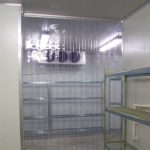Freezer Door Seals: Why are they Important for Energy Efficiency?
- 04 December 2017
A fully sealed freezer equals an energy efficient appliance, especially when that appliance assumes gigantic proportions. Furthermore, this threshold gasket stops the refrigeration unit from aging then failing in a wheeze of worn components. It’s strange how this often ignored enclosure cushioning can make such a big difference, but it really does. Regarded as an important part of the freezer system, door seals are built to conserve energy.
Rising Above Conventional Reasoning
What knee-jerk line of reasoning spins the wheels of the average mind here? There’s the notion that a substandard gasket will warp or wear. That damage will then cause a gap to form, which means the freezer envelope is compromised. Okay, there’s nothing wrong with that reasoning, but it is a little short-sighted. Think of the domino effect, the fact that this poorly installed or poorly manufactured lining is generating a number of ensuing issues. Chief among them, the compressor is bending over backwards to balance the leak.
It’s a Slippery Slope
What’s been proven thus far? The ‘bad’ door gasket on this hypothetical freezer isn’t performing at its best. If the elastomeric material doesn’t spring back into position after numerous door closures, the flexible lining is starting to look a little ragged around the edges. A leak develops, energy efficiency figures take a hit, and the problem worsens. The thermostat is still set at a desired subzero temperature, right? In all probability, the refrigeration unit will pull the interior temperature low, perhaps even as low as the frosty level marked on the thermostat. More than likely, though, the compressor inside that powered unit will be forced to run continuously. That always-on electrical box is certainly going to guzzle electrical kilowatts.
Detecting Less Obvious Door Seal Problems
It’s worth noting the way different rubbers react to thermal extremes. So far, the issues mentioned here have described situations where the door gasket becomes battered and warped. Sometimes, however, tiny cracks spread across the rubber. The elastomer losses its stretchy properties because of the cold temperature. The nearly invisible fractures leak energy, but the employees point their accusing fingers at the innocent refrigeration appliance or the wall insulating panels. Fortunately, a seasoned refrigeration technician knows better, because this individual will always check this high-impact threshold point for such hidden flaws.
Just like the energy wasted by a poorly performing door seal, it would be a waste of energy to deny just how important this threshold gasketing really is within the operating hierarchy of this wattage-hungry cooling system. It must be installed properly, perhaps even heated, and most definitely considered an important operational part of the freezing equipment’s pecking order.
Mark Connelly
C&M Coolroom Services
E-mail : markconnelly@cmcoolrooms.com.au
Mobile: 0412 536 315


